|
2002
Tour
By Alan Critchley
In September, I went
on a tour of the Anglo Zulu War battlefields organised by Adrian Greaves
of the Anglo Zulu War Historical Society. This was a fascinating trip
and most enjoyable.
I went to stay with
my brother who lives near to Johannesburg for the week before and met
the rest of the party at the airport on 15th. Sept. There were a couple
of others who did the same. We all met up at the airport and took the
coach provided down to Fugitives' Drift Lodge which is owned by Nicky
and David Rattray. I knew nobody and felt apprehensive about the trip
since we were such a mixed bunch.
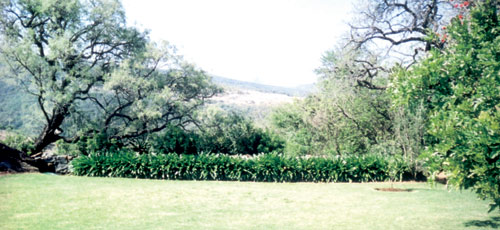
View from Fugitives' Drift Lodge with Isandhlwana in the
distance
In the party were Adrian and Debbie Greaves, Martin Everett, Ian Knight,
Cliff and Katie Stossel, Feda Holme (widow of Norman Holme), Edward and
Jenny Darwin, David Hann, Atalan Clifford, David and Suzanne Payne, John
Rourke, Jon Ross, Isobel Swan, Col. and Mrs. Duncan, Jason and Janet Askew
and Chris Sheane and John McAdam with whom I shared accommodation in the
Lodge Cottage.
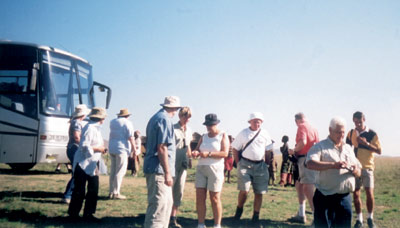
Other members of the party
On the five hour
journey down, we stopped at aMajuba Hill, battle site from the first Boer
War and had a picnic lunch. The site is maintained by the local Afrikaaners
since they gave the British a good thrashing there.
Mid afternoon arrived
at FDL thanks to the safe driving of Anthony our driver for the trip.
Later, an excellent dinner by Paul the chef. This was my third visit and
was warmly greeted by staff who I had met previously, including the delightful
Faith, Grace and Nicholas Nickleby who kept me in drinks.
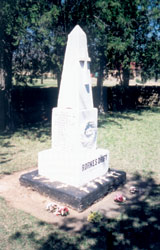
British memorial in the graveyard at Rorke's Drift
|
Day
two we visited Rorke's Drift with a brief talk from Ian Knight.
The local Zulus in their full regalia gave us a dance display. After
lunch at the Lodge, we revisited Rorke's Drift and were treated to
a gripping talk by David Rattray. We were frozen at the end of it.
Most of us not believing him when he warned us to take warm clothing.
By now I was getting on well with the others and my initial fears
were unfounded. John, Chris and myself shared the 'Cottage' and got
on famously. |
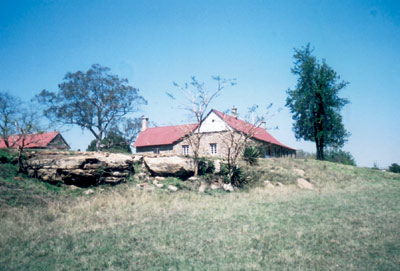
Site of the
hospital at Rorke's Drift as viewed from the Zulu attack from the south
Day three we visited Sihayo's Kraal, site of the first
engagement at the start of the War. We moved then to Isandhlwana, first
overlooking the site from the point where the main Zulu force first came
into view. On the battlefield itself, we had a short talk from Ian Knight,
visited the area where the artillery were believed to have been, and the
line where the British troops were in their lines.
In the afternoon, most went to the site where Melvill and Coghill were
killed and to see their graves and memorial. I bravely went horse riding
with a few others in the game reserve and had a fantastic view of the
Buffalo River in the gorge below. My horse was called Charlie Raw, possibly
named after the state my bottom was in, not being a horse rider.
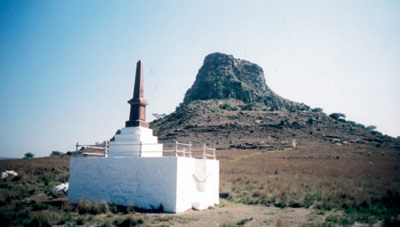
Isandhlwana and memorial
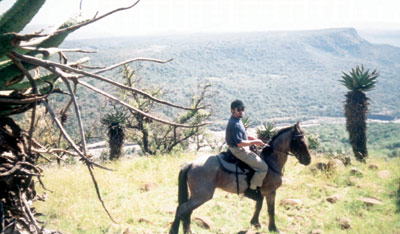
Me on 'Charlie Raw'
Day four we went to Helpmakaar and saw the British cemetery
there. We moved then to Blood River and the amazing circle of 38 or so
full size bronze laagered wagons which form the main attraction there.
We crossed the river to visit the recently opened Zulu museum (bit of
politics here) the plan of which is in the shape of the horns of a buffalo
formation. Here we had a picnic lunch.
The afternoon was
a visit to the Prince Imperial memorial. There are two graves on the site,
troopers Abel and Rogers. Where the hoards of children appear from I have
no idea. Perhaps it's in their blood. There were thousands of 'em. Well,
dozens.
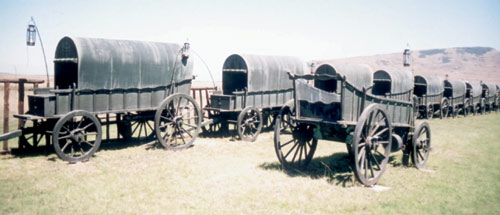
Bronze wagons at Blood River
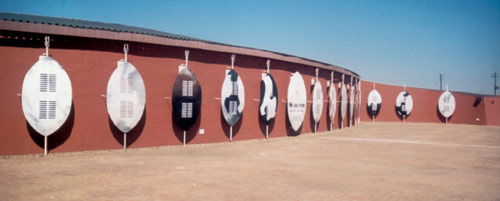
Zulu museum at Blood River
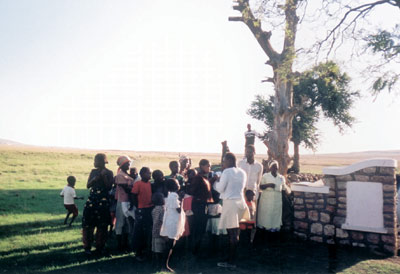
Locals ar the Prince Imperial site
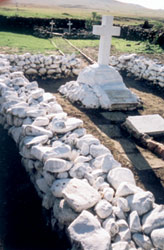
The Prince Imperial Memorial
Day five was exhausting. We went to Isandhlwana and the
fit (plus me), walked the fugitives' trail with guide Paul Marais who
turned out to have malaria and went to hospital. About five miles up and
down over rocky terrain in the heat. When we reached the Buffalo River,
I swam across alongside Ian Knight who was still wearing his hat. Still,
the river cooled us down a bit.
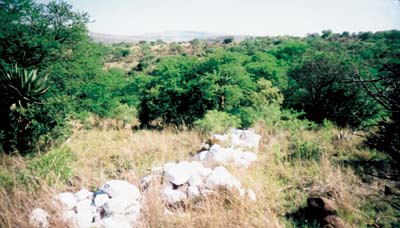
View of Isandhlwana from along the Fugitives' trail
Day six some went on a game and scenic walk. Again I
went horse riding (glutton for punishment) and saw many game animals including
Giraffes, Zebras, Wilderbeast etc.
In the afternoon
we went to the Ngebweni valley where the assembled Zulu army was discovered
by Charlie Raw, (not my horse). Again, in the middle of nowhere, we were
surrounded by hoards of young children.
We the went to Mangeni
Falls, accompanied by David Rattray, where Chelmsford had his camp after
he left Isandhlwana with half of his force. Again hoards of children,
and dogs.
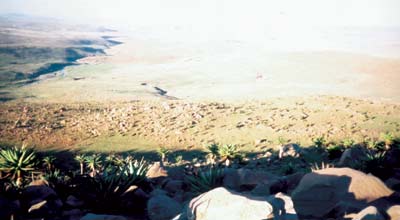
Ngebweni valley
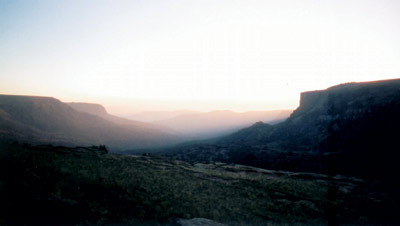
Sunset at Mangeni Falls
Day seven. Most went to Ulundi, the site of the final
battle and saw the memorial there and also visited the memorial to Piet
Retief. They dropped me at Isandhlwana on their way so that I could wander
around alone. I went to the firing line and the donga where Durnford held
the left horn of the Zulus off for a while. I followed the route of his
retreat to the camp and position of his final stand. I went up Isandhlwana
to Younghusband's last stand with his men and their cairn. Up then to
the cave where the last soldier to die made his stand. Across the neck
and up then to Black's koppie with it's panoramic views over the whole
scene, Isandhlwana, views back to fugitives' drift, the Oskarberg, Russell's
battery position, and Chelmsfords route to Mangeni Falls. A highly recommended
vantage point.
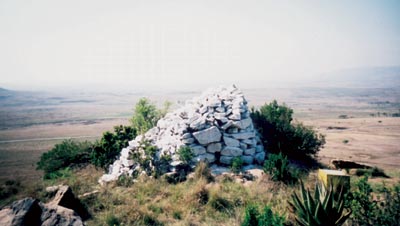
Younghusband and company cairn
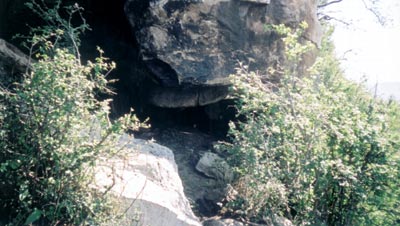
Cave of last survivor at Isandhlwana
Day eight
we all attended a church service in the church built on the site of the
storeroom at Rorke's Drift. It was very interesting, and the Zulu singers
had excellent voices, great baritone section, their tenors weren't as
good as the Welsh mind! We had the opportunity to show our ability to
match them by singing a hymn. Let's leave that one. They did ask for our
printed sheets so no doubt next time we go they will show us how it should
be done.
After the service
we were treated to a dance display by the local Zulu re enactment group.
They were extremely good and the prospect of 4,000 of them made me very
thoughtful.
After lunch I again went horse riding, again on Charlie Raw. This time
we rode down to the Buffalo River, calling in at Melvill and Coghill's
grave on the way.
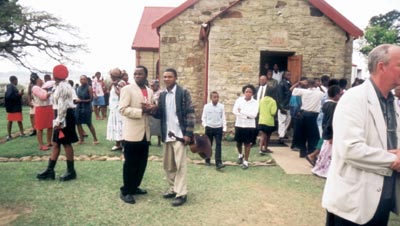
After the church service
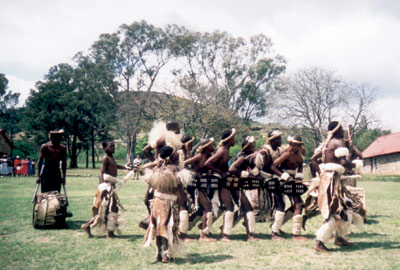
The Zulu dancers
Day nine some of us again visited Isandhlwana. Again
I went up Black's koppie with John McAdam and Martin Everett. In the afternoon
we visited the school at Rorke's Drift. They had been supplied with 18
computers provided by the Royal artillery or Rotary Club (not sure which)
in Britain which were promptly stolen. These have been replaced by the
RSA government but they don't have the use of them because of software
problems. There is also a community hall which was built by the Royal
Artillery, although it's still without electricity. In the evening there
was an after dinner talk by David Rattray.
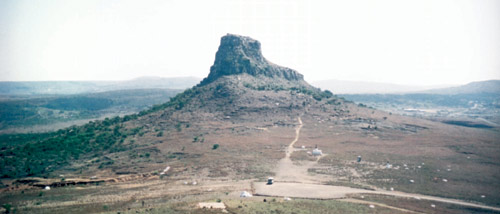
Isandhlwana from Black's koppie
Day ten
was the goodbyes. The return drive to Johannesburg and again a stop for
lunch at aMajuba. At the airport, I said my goodbyes to people that 10
days earlier had been strangers. They flew to London and I stayed with
my brother in Johannesburg for a further two weeks.
All in all, a brilliant
time, and most memorable. Can't wait for my next visit in April with the
RDVC trip.
Alan
Critchley
rorkesdriftvc.com
Back
|

